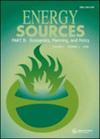CO2 intensity of GDP, energy productivity and environmental degradation in Iceland: evidence from novel Fourier based estimators
IF 2.2
4区 工程技术
Q3 ENERGY & FUELS
Energy Sources Part B-Economics Planning and Policy
Pub Date : 2023-05-19
DOI:10.1080/15567249.2023.2214906
引用次数: 0
Abstract
ABSTRACT Iceland aims to achieve carbon neutrality by 2040 and to cut carbon emissions by 40% by 2030 under the Paris Agreement. Iceland’s major policy instrument for reaching its emissions reduction and carbon neutrality objectives is a Climate Action Plan, which was amended in 2020 and included 48 initiatives. Therefore, the research investigates the impact of carbon intensity, economic growth, globalization, and energy productivity on consumption-based emissions in Iceland from 1995Q1 to 2019Q4. The Fourier Autoregressive Distributed Lag Model (FARDL) is used in this study to investigate the ramifications of a long-term association. Long-run estimations demonstrate that Iceland’s environmental quality is deteriorating due to carbon intensity and economic development. It implies that increasing the carbon intensity and economic growth is environmentally damaging. Furthermore, economic expansion has a significant impact on environmental sustainability. Increased energy production also decreases consumption-based emissions, which contributes significantly to Iceland’s sustainable environment. Globalization has a positive and significant influence. A 1% rise in globalization, in particular, enhances consumption-based emissions over time. The finding is crucial for policy preferences and might be used to implement robust policy measures to address environmental challenges.二氧化碳强度的GDP,能源生产力和环境退化在冰岛:证据从新颖的傅立叶为基础的估计
本文章由计算机程序翻译,如有差异,请以英文原文为准。
求助全文
约1分钟内获得全文
求助全文
来源期刊

Energy Sources Part B-Economics Planning and Policy
ENERGY & FUELS-
CiteScore
6.80
自引率
12.80%
发文量
42
审稿时长
6-12 weeks
期刊介绍:
12 issues per year
Abstracted and/or indexed in: Applied Science & Technology Index; API Abstracts/Literature; Automatic Subject Index Citation; BIOSIS Previews; Cabell’s Directory of Publishing Opportunities in Economics and Finance; Chemical Abstracts; CSA Aquatic Science & Fisheries Abstracts; CSA Environmental Sciences & Pollution Management Database; CSA Pollution Abstracts; Current Contents/Engineering, Technology & Applied Sciences; Directory of Industry Data Sources; Economic Abstracts; Electrical and Electronics Abstracts; Energy Information Abstracts; Energy Research Abstracts; Engineering Index Monthly; Environmental Abstracts; Environmental Periodicals Bibliography (EPB); International Abstracts in Operations Research; Operations/Research/Management Science Abstracts; Petroleum Abstracts; Physikalische Berichte; and Science Citation Index.
Taylor & Francis make every effort to ensure the accuracy of all the information (the "Content") contained in our publications. However, Taylor & Francis, our agents, and our licensors make no representations or warranties whatsoever as to the accuracy, completeness, or suitability for any purpose of the Content. Any opinions and views expressed in this publication are the opinions and views of the authors, and are not the views of or endorsed by Taylor & Francis. The accuracy of the Content should not be relied upon and should be independently verified with primary sources of information. Taylor & Francis shall not be liable for any losses, actions, claims, proceedings, demands, costs, expenses, damages, and other liabilities whatsoever or howsoever caused arising directly or indirectly in connection with, in relation to, or arising out of the use of the Content. Terms & Conditions of access and use can be found at http://www.tandfonline.com/page/terms-and-conditions .
 求助内容:
求助内容: 应助结果提醒方式:
应助结果提醒方式:


